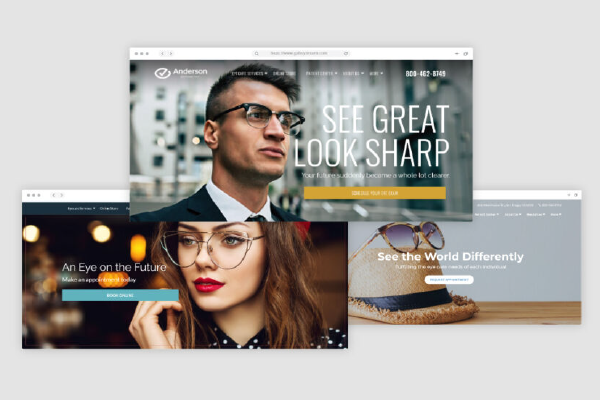10 Eye Care Social Media Mistakes to Avoid
In today’s world, social media is one of the most cost-effective methods of engaging with your eye care patients and staying top of mind. Actively using platforms like Facebook, Instagram, and Twitter gives your practice more exposure and allows you to incorporate social media into your marketing strategy.
If you are not active on popular social platforms with the intent to increase awareness of your eye care practice, you are missing the opportunity to build meaningful relationships with followers.
In order to use social media to its full potential, it’s important that you follow some guidelines to secure your success in improving your social media presence. Follow along as we list the most common mistakes that you should avoid on social media.

1. Not Having a Social Media Plan Ready
Many people believe that just posting on social media here and there will help them reach their goals, but working without a plan can do the opposite. You should approach your social media plan the same way that you do your marketing strategy.
Set up a calendar with dates, specific objectives, how you will achieve those objectives, content that will be posted for each day you choose, budget (if paying for social ads), and how you will be measuring the results of your social metrics.
If you will be using any additional social media tools like Sprout Social, Coschedule, or other programs, to schedule posts, edit content, or organize the layout of your pages, be sure to include these in your plan as well.
Here are a few eye care pages you can follow find inspiration from:
- National Eye Institute – check out this government agency page for general eye health information and updates about the industry.
- American Optometric Association – this page posts optometry specific information regarding news, conventions, and educational content.
Read On: Eye Care Social Media Marketing Ideas to Boost Engagement
2. Treating Each Social Media Platform the Same
Is some content transferable between multiple platforms? Sure! But, does this mean that you should not take into account what type of content performs best on each social network? Absolutely not!
You must address the audience on each platform in a way that is consistent with the norm. There are different things to consider on each network such as caption length, the voice you use, and image formatting, as well as which posts spark the most engagement.
For instance, video content performs the best on Facebook, so it would be in your best interest to incorporate videos into your social plan for this platform.
This is an example of an eye care video about computer vision syndrome that provides useful and easy to digest information for the viewer.
Instead of just sharing the exact same content across all platforms, also known as cross-posting, craft a new and unique message per network that is optimized for that platform and encompasses the language and customs of that website.
3. Not Actively Engaging in Conversation

This may seem pretty obvious, but social media is meant to be a conversation between you and other users. You should not just post online, log off, and not worry about any of the engagements that you are receiving.
One of the most efficient ways to boost your engagement, in fact, is to talk to your followers! If a user asks you a question or comments on one of your posts, use this opportunity to respond to them. Each of your posts should aim to elicit conversation from our following, and when it does, be sure to reply.
Even if someone leaves a negative comment, you should never ignore it. Was a patient not satisfied with eye evaluation? Are they unhappy with their new glasses? Respond to those as well to show that you want to resolve the issue and improve the experience they have had with your business. This is an opportunity to learn and make the necessary changes to make sure it does not happen again.
Be professional, but also personable with your responses so you can begin to build long-lasting, trustworthy relationships online.
Learn More: How to Gather Feedback on Social Media
4. Ignoring User-Generated Content
User-generated content, or UGC, is any content (images, videos, text, audio, review, etc.) created by users instead of brands. When people post UGC, the brand mentioned will usually share it on their social media channels, through email, on their website, or other marketing channels.
For example, if someone comes to your ophthalmology practice for a LASIK procedure, they may share a video post-operation about how excited they are to have finally gotten LASIK performed by you and not have to wear their eyeglasses any longer. You could share this video on whatever platform you choose to generate more interest from other potential patients.
Another example would be if someone comes into your optical shop to purchase a new pair of glasses. Once they’ve made their selection, they may post a photo in their new glasses and encourage others to come to buy their glasses at your store. Users are likely to be moved by UGC and also see it as genuine and more believable than content posted by a business.
5. Failing to Produce Video Content

Video, especially on platforms like Facebook and Instagram, is more important now than it has ever been. The way that we consume information constantly changes and video is currently ruling the social media space.
According to Cisco, by 2022, online videos will make up more than 82% of all consumer internet traffic. If you have not already incorporated video marketing into your social media strategy, now is the time.
Some video ideas for eye care practices include:
- The importance of eye exams
- Bad habits that affect your vision
- Symptoms of pink eye
- Dry eye treatments
- Choosing between glasses or contact lenses
- The differences between LASIK, PRK, and SMILE
- Common eye diseases
- Tips for healthy vision
- The differences between optometry, ophthalmology, and opticianry
- Other eye health-related topics that you believe will interest your audience
Adding video to your marketing strategy allows you to add unique messaging to your brand’s social media presence, drive conversions, personalize your eye care practice, and so much more.
6. Focusing on Quantity vs. Quality
Many businesses will post as much as possible to their social channels because they believe that appearing on a user’s feed as much as possible will increase their engagement, but it’s not true. In fact, if you post too many times a day, patients who follow you may become disengaged by the constant posting and unfollow.
So, instead of arbitrarily posting, focus on sticking to a schedule of creating quality content that is relevant or useful to your target audience and share it on your social accounts.
Think about the value that your content is contributing to someone’s life and what they gain by interacting with it. This helps to establish a valuable relationship with your audience and you also get to provide them with interesting content about eye care.
7. Only Sharing Your Own Content on Social Networks
Sharing is caring, and this doesn’t just apply to your belongings. Sharing ideas, informational updates, or educational pieces created by others in the eye care industry is beneficial to both parties.
Sharing other trustworthy resources by eye care professionals that are considered authoritative figures establishes your page as a place to discover solid information about your niche. This is also another way to enhance the trust that users have in your brand.
Also, when you continuously share another source’s blogs, infographics, images, etc., they will most likely notice and begin to engage with your content as well and share it to their page. This now expands your reach to their following as well.
8. Not Completing Your Eye Care Profile

When you create a profile on any social media site, especially Facebook, it’s important to complete that profile to give users all the information they need to know about your eye care office. The “About” section on your profile can set the bar for how your eye care practice is perceived.
The about section contains categories that allow you to share essential information about your practice when your business was founded, your mission statement, official name, email, business hours, phone number, website, location, and more. When you complete your profile, users will see your business as trustworthy and also know all the necessary information needed to reach you.
9. Buying Social Media Followers
Buying followers, especially on Instagram, may be tempting because having a large following is appealing to users, but this is a big no for multiple reasons. Having a big platform does not guarantee that your social pages will be successful or that you’ll receive the engagement you are hoping for.
When you buy them, it will most likely be inactive accounts or bots, and therefore they will not interact with your posts the way a real person or active user would. The community that you build online should be authentic to avoid harming your credibility.
Instead of buying followers, increase your following by:
- Making your profile public
- Engaging with your audience in the comment section
- Post content that truly interests users
- Use each social platform to its fullest capability
10. Ignoring Your Social Media Analytics

You may be posting great content on all your social accounts, but are you analyzing your metrics in order to see if your social media campaign is a success? It’s important to know how each of your posts is performing to give you insight into what you should continue to post and what you should probably avoid in the future. Setting goals will help you determine if your eye care practice is hitting the mark or not.
Tracking your engagement encompasses clicks, mentions, likes, comments, shares, and views (Facebook, Instagram, LinkedIn, and Twitter) or retweets (Twitter). With each platform, you can view how each and every post fared amongst your audience.
If you are looking for a more in-depth marketing tool to further analyze your metrics, choose one of the following tools to help you better understand how your eye care practice is doing.
Bonus Tips for Eye Care Practices
Now that we’ve discussed tactics that you should not use on your social media plans, here are a few tips on things you should be doing.
- Be consistent
- See what other eye care professionals, especially competitors are doing online
- Keep an eye on trending topics and join hashtag to be part of the conversation
- Join communities of other eye care professionals
Why Social Media is Important for Eye Care Professionals
Once you have a marketing strategy in place and have decided on your objectives with your social media channels, now begins the execution.
Crafting eye care content that patients will like and engage with while also increasing interest in your business should be the goal. If you were a patient following your eye care provider, think of what type of posts would inspire you to engage the most and get to creating. Just be sure to avoid these 10 mistakes as you create your campaign!
How We Can Help Eye Care Professionals With Social Media
We specialize in all aspects of marketing outreach, including social media, and would love to help you get active. If you need a little help before you dive in, give us a call at 800.792.8384 or click here and we can show you how to attract your ideal eye care patients.
Don’t forget to follow iMatrix on Facebook where we share eye care content and marketing tips for you!



